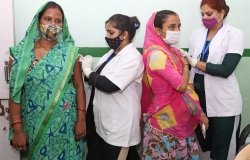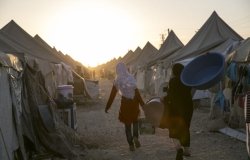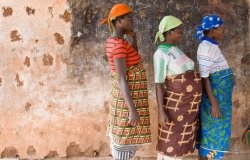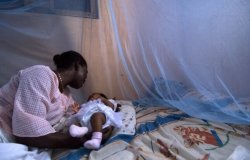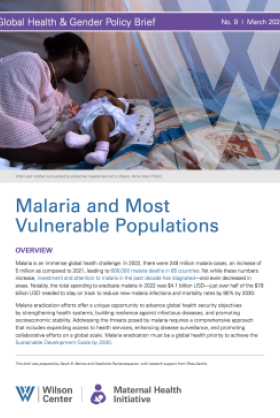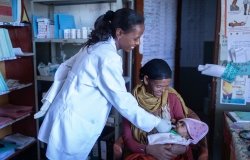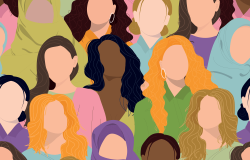Cover of Connecting the Dots Report, designed by Tanja Bos. Used with permission courtesy of Population Institute
Connecting the Dots for Gender Equality and Empowerment
The Wilson Center’s Maternal Health Initiative, in collaboration with the Population Institute, hosted the official launch of the Connecting the Dots report’s findings and recommendations, followed by a panel discussion on the importance of increased financial and political support for sexual and reproductive health and rights to improve the health, wellbeing, education, political and community engagement, and safety and security of the world’s women and girls.
Overview
“Women’s ability to access education, pursue a career outside the home, or participate politically often hinges on their ability to exercise control and autonomy over their own bodies and reproduction,” said Sarah Craven, Director of the North American Representation Office at UNFPA at a recent Wilson Center event, hosted in partnership with Population Institute, to launch their new report, Connecting the Dots: Sexual and Reproductive Health and Rights as Prerequisites for Global Gender Equity and Empowerment.
Craven added that despite significant milestones in the recognition of women’s reproductive rights since the 1994 International Conference on Population and Development (ICPD) and the fourth world conference on women in Beijing in 1995, women a generation later continue to face substantial disparities in education, income, autonomy, and political power compared to men. “According to UN projections, at our current rate of progress,” she continued, “it will take another 286 years for the world to achieve gender equality.”
The Connecting the Dots report demonstrates the direct impact that the availability and accessibility of comprehensive sexual and reproductive health services has on improving overall health and equal participation in education, the paid workforce, and politics.
“Channeling efforts to improve gender equality and women’s empowerment without connecting the dots between women’s access to sexual and reproductive health and rights (SRHR) and participation in education, the paid workforce, politics, and peacebuilding would inevitably weaken all of those efforts,” said Maniza Habib, report co-author and Research Associate at Population Institute.
Engaging and Empowering Young People
Speakers at the event emphasized the importance of prioritizing youth engagement and health needs to connect the dots. Habib noted that “1.8 billion people ages 10-25 are living in this world currently – the largest youth generation in history – and these numbers are just expected to grow.”
Yet youth representation in policymaking and governance rarely meets their substantial demographic presence. Humphrey Nabimanya, CEO and Founder of Reach a Hand Uganda, a youth-led organization focused on HIV and AIDS awareness and prevention, observed that youth comprise only 2% of the Ugandan Parliament, despite making up more than 70% of the population. He urged nations to create more youth political representation to take charge in designing and implementing effective policies and monitoring whether these policies work for the whole population.
Such youth empowerment is key to achieving global gender equality goals. “We know that girls who are educated, have more information about SRHR, and highlighting those important connections is key to bringing SRHR into the equation,” said Bridget Kelly, the moderator of the event and lead author of the new report.
Services such as comprehensive sexuality education empower young people to understand who they are and make informed choices, said Nabimanya. Doing so can make youth more economically independent and able to live a healthy life, as well as help fight against HIV and AIDS, he added.
Measuring the Impact of United States’ Investments
Currently, 218 million women in low-and middle-income countries have an unmet need for modern contraception, and the estimated total funding resources necessary to meet this need is $12.6 billion (USD). The United States is the largest donor to international family planning efforts, yet its allocation is a fraction of what is needed to achieve optimal health and wellbeing for women at a global level. The need to secure US funding for family planning and reproductive health at a level that is appropriate, justified, and a ‘fair share’ of the global financial burden was a significant takeaway from the Connecting the Dots report.
“By [fair share], we mean, what it would look like for the [United States] to really do its part to tackle this global challenge,” said Caitlin Horrigan, Senior Director of Global Advocacy at Planned Parenthood Federation of America. The fair share calculation for the United States’ international aid contribution—based on the overall unmet need for modern contraception and the country’s relative wealth compared to other donor nations–should be $1.736 billion (USD) for bilateral and multilateral funding for family planning and reproductive health programs.
The current US appropriation of funds is $607.5 million (USD), which is roughly a third of the calculated fair share. While this number has remained stagnant for years, the Senate recently proposed a $27.5 million increase to the current appropriation of funds to family planning and reproductive health programs—a move that has bipartisan support. Horrigan noted that while this increase is significantly below the “fair share,” it is a positive step in the right direction towards increasing access to essential services.
US government actors have also reaffirmed their commitment to global gender equity and SRHR through legislation and policies, which are evaluated in the SRHR Index. The Index grades each actor on the domains in which they work – family planning, maternal and child health, and HIV & AIDS.
“These domains should not be thought of as what’s important in US global health assistance, rather it is what is funded in US global health assistance,” said Bergen Cooper, Director of Policy Research at Fòs Feminista and architect of the SRHR Index.
Within each domain, actors are graded on what is being done in the field compared to what should be done. Cooper added that “the Index allows us to assess the US government’s ability to reach long excluded groups and it does that by using what we call ‘crosscutting issues.’ We score whether the action is based in evidence, responsive to need, situated within internationally recognized human rights norms, and if it is gender transformative.”
Breaking Down Silos to Gender Equality
Promoting and delivering the full range of SRHR services cannot happen without breaking down the silos within global health and development programs. One example where the lack of integration of SRHR can lead to fragmented care is during an emergency or crisis, when the immediate focus is often on more visible and urgent needs, such as food, shelter, and water.
In these situations, the “MISP” or the Minimum Initial Service Package, a set of life-saving SRH interventions to be implemented at the onset of a crisis, is often overlooked or treated as an afterthought. However, this oversight leads to increased risk of maternal and newborn deaths, sexually transmitted diseases, and gender-based violence. “It is our job to hold this government and other governments accountable for ensuring that sexual and reproductive health services are available at the onset of an emergency,” said Cooper. “This is not a problem for later, this is an issue to be dealt with immediately in every emergency.”
SRHR is critical to achieving established bipartisan gender equality goals, said Kelly. The Connecting the Dots report reveals that women’s economic participation is inextricably linked to their ability to choose the timing, spacing, and number of births. And ensuring that women have a decision-making role in humanitarian and fragile settings can improve provision of SRH services and enable pathways to peace. While conversations surrounding SRHR are often overlooked for being contentious, she added, it is essential to shift from the siloed thinking and recognize the transformative power of SRHR in advancing these goals.
Craven stressed that the report demonstrates a clear understanding of effective solutions to advance gender equality: “We don’t need a silver bullet or a cure, we know what to do. What we need is political will.”
Written by Rhea Kartha and Deekshita Ramanarayanan, edited by Richard Byrne.
Keynote Speaker

Sarah Craven
Moderator

Bridget Kelly
Panelists

Bergen Cooper

Caitlin Horrigan
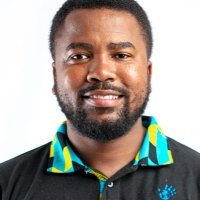
Humphrey Nabimanya

Maniza Habib
Hosted By

Maternal Health Initiative
Life and health are the most basic human rights, yet disparities between and within countries continue to grow. No single solution or institution can address the variety of health concerns the world faces. By leveraging, building on, and coordinating the Wilson Center’s strong regional and cross-cutting programming, the Maternal Health Initiative (MHI) promotes dialogue and understanding among practitioners, scholars, community leaders, and policymakers. Read more

Environmental Change and Security Program
The Environmental Change and Security Program (ECSP) explores the connections between environmental change, health, and population dynamics and their links to conflict, human insecurity, and foreign policy. Read more
Thank you for your interest in this event. Please send any feedback or questions to our Events staff.


